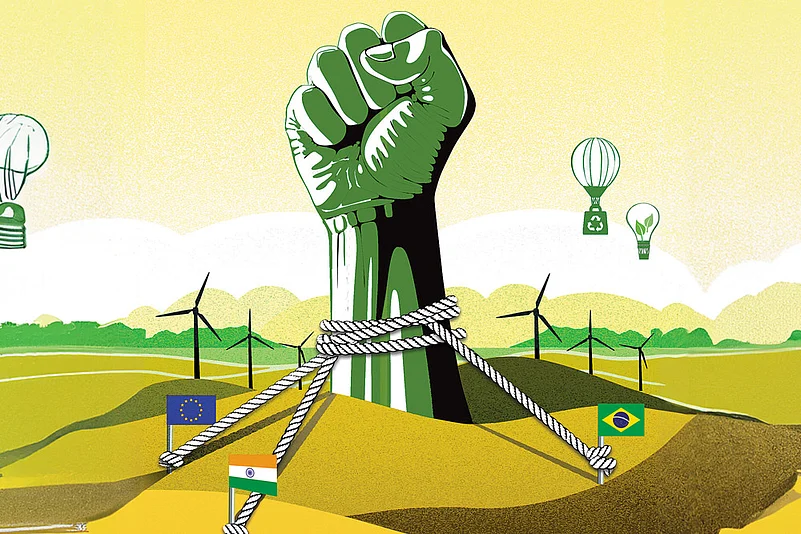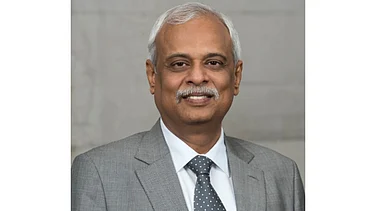At the 28th edition of the Conference of the Parties (COP) to the United Nations Framework Convention on Climate Change (UNFCCC), held in Dubai last month, Prime Minister Narendra Modi offered to host the 33rd edition in India in 2028.
Since the first meeting of the COP, the conference has grown into one of the largest and most important intergovernmental meetings. According to the UNFCCC handbook, titled How to COP, the total number of participants at COP25 was 22,472, which included government delegates, intergovernmental organisations, non-government organisations, etc. Hosting the now-bigger COP aligns with Modi’s agenda of positioning India as the Vishwa Guru (global teacher) and driving international diplomacy with the idea of Vasudhaiva Kutumbakam (one earth, one family, one future).
In this context, the benefit suggested by the UNFCCC handbook, which calls it “an exciting way for a country to step into the global spotlight and showcase its commitment to combating climate change”, is just what India under Modi seeks. The document observes that past COP presidencies have experienced that their outreach efforts and improved communication helped the government advance its national agenda, including discussions on nationally determined contributions and national adaptation plans.
The COP is held on a rotational basis every year and it will be the turn of the Asia-Pacific region to host it in 2028. As per UN rules, India can be the host only if all countries in the region unanimously agree to its bid. It hopes to amplify its pitch with the success of the Voice of Global South Summit 2023 and the G20 summit in Delhi where, as the group president for the year 2023, it managed to whip up the New Delhi Declaration after relentlessly pushing for a consensus among reluctant nations.
Dealing with Conflicts
COP28 made headlines for several reasons, both positive and negative. While on the brighter side, the member countries mobilised a Loss and Damage Fund to assist poorer and vulnerable nations which are at the highest risk from global warming, the appointment of the COP president from an oil company was a conflict of interest that triggered murmurs of dissent in many corners. Sultan Al Jaber, the president of COP28, is also the chief executive of the Abu Dhabi National Oil Company. Leaked documents alluded to attempts by Al Jaber to strike fossil fuel deals during the summit. Besides, UAE, the host nation, is also among the top producers of oil in the world, which put it in direct conflict of global climate action goals. However, according to UAE Prime Minister Sheikh Mohammed bin Rashid Al Maktoum, the country’s “determination, its strong diplomatic relations with global nations and pragmatic position on climate action, underpinned by proven experience in the energy and sustainability sectors led to the nation securing the international consensus” to host the COP28.
Conflicts surfaced during the selection of the COP29 host, to be held later this year, as well. Azerbaijan was chosen after much deliberation. This upper middle-income nation has seen significant economic growth in the last decade that is credited to an increase in its oil and gas production which constituted 88% of the country’s exports in 2016. According to US international development agency USAID, Azerbaijan’s rapid economic development has intensified air pollution, loss of forests, contamination of water and a rise in the Caspian Sea, one of the largest landlocked water bodies of the world. More than half of the country’s greenhouse gas emissions have been due to its energy sector.
However, it has a few factors working in its favour. Azerbaijan has signed the Paris Climate Agreement and has plans to align climate change legislation in the country with EU standards. The country has also adopted mitigation actions to address energy efficiency in buildings, modification of transportation by focussing on use of hybrid cars and eco-driving and oil industry.
The India story is not very different. It has political and economic compulsions to press the growth peddle. It has to adjust its climate action in this context.
Building a Case for India
India has often found itself under severe international scrutiny for its emissions. Climate Action Tracker, a research group, rates the country’s climate targets and action as “highly insufficient”. It further notes that the government has continued its support to coal and is increasing its reliance on coal and gas to meet energy demands. Its National Electricity Plan (NEP) 2023 “envisages more than 150% increase in additional coal capacity in the second half of the decade”, the agency states.
Will India’s development-oriented climate-unfriendly actions affect its leadership at COP33? Unlikely, considering that it is at the forefront on multiple parameters relevant to the discussion on climate change. It is the third largest emitter of greenhouse gases and has several of its cities among the top 100 most polluted cities in the world. This makes it a major stakeholder in any climate discussion, without whose active participation and commitments, no major progress will be possible. But alongside, it is also one of the most formidable voices among developing countries as also the fastest growing global economy with a huge demographic dividend. For the global south to push back against the hegemony of the global north, it needs India.
India has also made some noteworthy progress towards fulfilling its climate action commitments. In Dubai, when Al Jaber extended a special invitation to Modi to speak in the plenary session—he was the only head of a government to get the honour—the latter did not miss the opportunity to build a case for India as a climate action champion and harp on its achievements in meeting its goals. He reminded the audience that India, despite accounting for 17% of the global population, was responsible for less than 4% of emissions, before going on to highlight the progress made so far towards achieving climate goals.
In its nationally determined contribution (NDC) targets, India had indicated that it would achieve 50% of non-fossil fuel capacity target. According to the Ministry of Power, thermal power accounts for 56% of the total energy platter of the country. According to the NEP estimates in 2023, the installed renewable energy capacity of India will reach 55% of the total energy capacity in 2026–27 from 39.2% in 2021–22, while that of coal and lignite capacity will likely go down from 58.2% in 2021–22 to 39% in 2026–27.
“Balancing rapid growth in energy demand with the imperative of reducing greenhouse gas emissions presents a unique challenge. India’s approach, focusing on a significant shift towards renewable energy by 2030, highlights its commitment to sustainable development,” says Harjeet Singh, global engagement director for the Fossil Fuel Treaty initiative.
The private sector in India has been taking initiatives in climate action. Santhosh Jayaram, global head for sustainability at HCL Technologies, says, “The presence of private sector has expanded in the last two COPs and this is because businesses recognise their role in the low carbon pathway and that they too face challenges related to climate change. The involvement of the private sector is key to championing innovations in technology to move towards net-zero and mobilising climate finance.”
Vedanta Aluminium, purportedly the largest aluminium manufacturer in the country, is making efforts to reduce its carbon emissions. “Technological and product innovations, such as India’s first low-carbon green aluminium, branded Vedanta Restora, have resulted in an impressive 28% reduction in greenhouse gas intensity in FY23 compared to a baseline of FY12, alongside a threefold increase in production. This underscores the fact that ecological well-being and economic growth are in fact two sides of the same coin. Vedanta’s commitment to sustainability, therefore, closely intertwines with India’s climate leadership efforts, as the nation gears up to potentially host COP33 in 2028,” says John Slaven, CEO of Vedanta Aluminium.
In the national statement at COP28, India’s climate change minister Bhupender Yadav stated that the country has reduced the emission intensity vis-a-vis its GDP by 33% between 2005 and 2019, thus achieving the initial target under NDCs for 2030 almost 11 years ahead of the schedule. “India has also achieved 40% electric installed capacity through non-fossil fuel sources, nine years ahead of the target for 2030. Between 2017 and 2023, India has added 100 GW of installed electric capacity, of which around 80% is attributed to non-fossil fuel resources,” he said.
However, there have been frequent calls for India to do more. Critical of the pressure exerted by developed nations on the developing ones, Sandeep Pai, research director at Swaniti Global, a think-tank working on climate and energy issues around the world, says, “More often than not, COP agendas inside and outside—whether formally or informally—are set by global north actors. From the number of delegates to attendees, the ratio is skewed towards global north actors and their interests.” He is optimistic that, given India’s size and position in the world stage, it can make COP33 a conference truly meaningful for the global south.

Seeking Equity
India has been demanding that climate discussions be held around equitable per capita emission since the time it hosted COP8 in 2002 during the term of then Prime Minister Atal Bihari Vajpayee. The argument, as India has been reiterating in no unclear terms on every relevant global platform, is that the country’s population—as also its ever-growing energy demand—is just too large to allow a significant cut in fossil fuel dependence while safeguarding its economic growth interests.
In the global dialogue on climate action, the focus often shifts to countries like India, with calls for them to reduce their absolute emissions. However, this demand overlooks a crucial aspect of climate justice, says Singh. “While India grapples with its developmental challenges and strives towards a sustainable future, the narrative on emissions cannot be divorced from the context of equity. Developed nations, despite their historical responsibility and higher per capita emissions, continue to expand their oil and gas extraction. This expansion contradicts their moral stance on urging emerging economies to curb emissions,” he points out.
He is critical of the failure of developed countries to honour their climate finance obligations, which are crucial for enabling developing nations to transition to cleaner energy. “This breach of promise leaves countries like India to rely heavily on their own financial and technological resources in their journey away from fossil fuels,” he says, insisting that the call for reducing emissions be accompanied by a recognition of these disparities and a renewed commitment to equitable climate action.
India has been seeking international climate justice, pushing for developed nations to honour their commitment of $100 billion annual climate finance to assist developing countries in making a just transition to greener economy. “Over the recent years, India has set a remarkable example of ‘just transition’, striking the right balance between climate action and economic progress for the passage towards a resilient future,” says Dipankar Ghosh, partner and leader, Sustainability and ESG at BDO, India.
“Just transition involves not only the creation of new job opportunities in green sectors and the reskilling of workers from fossil fuel industries but also ensuring that the transition does not exacerbate socio-economic inequalities. India’s efforts in this direction are not just crucial for its own population but are vital to global climate change mitigation efforts,” Singh adds.
India’s Leadership Game
Under its G20 presidency, India launched the Global Biofuel Alliance and Green Development Pact as part of the New Delhi Declaration, which facilitates the trade of sustainable biofuel. At COP28, it also participated in three high-level side events, two of which it co-hosted with the UAE. One of these was the launch of the Green Credits Initiative—to create a participatory platform at a global level for exchange of innovative environmental programmes and instruments—and another on climate finance. The third one, co-hosted by India and Sweden, was the launch of LeadIT 2.0, or the second phase of Leadership Group for Industry Transition for the period 2024–26, which will work towards energy transition. This was a joint initiative launched by India and Sweden in 2019 at the UN Climate Action Summit in
New York.
India looks to host COP33, showcasing transformational leadership—leading by example—and while it is a welcome gesture, much remains to be deliberated upon and thought through regarding its domestic pathways to cutting down its emissions to meet the Paris Agreement.
By hosting the conference two years before 2030, when the world does its first major stocktaking of progress towards sustainable development goals, India will have the opportunity to showcase its commitment to climate action. However, there will be a lot of pressure on it to come clean on its policies towards meeting climate goals before that. This might be a tough nut to crack in the backdrop of India’s ambition to become a developed nation by 2047. While its exports are largely services-driven, the government is pushing manufacturing, which will lead to more pollution unless it uses clean energy and reduces its carbon intensity.
Besides pushing for just transition internationally, it will have to ensure the same intra-nationally. At the policy level, it will be required to align its national policy frameworks and facilitate investment flow to states with coal-dependent economy to make a transition to renewable energy. Currently, majority of the investment is concentrated in western and southern states. For instance, Rajasthan, Gujarat, Karnataka, Tamil Nadu and Maharashtra top the list of states with highest installed solar power capacity as of June 30, 2023, according to the Ministry of New and Renewable Energy and Power.
At COP8 in 2002, Prime Minister Vajpayee had argued that India’s per capita greenhouse gas emissions were “only a fraction of the world average, and an order of magnitude below that of many developed countries”. If selected to host the bigger and wider-reaching COP33, India might need a different argument, one where it can balance its own interests, and of other developing nations, with those of the planet and come up with a viable solution to address the climate crisis.






























